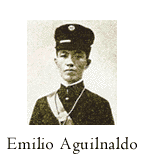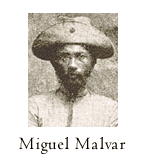|
American
Campaign of Brutality
 The
Philippine-American War was a war of attrition. The
Americans identified their objective as the capture
of Emilio Aguinaldo, the President of the fledging Philippine
Republic. They initially perceived conquest and pacification
as dependent on the fall of the Aguinaldo government.
Because of their superiority in weapons, they also believed
that the war would be short and swift in their favor.
But the Americans were shocked at the courage and tenacity
of the Filipinos who dragged the Americans into several
years of battle. The
Philippine-American War was a war of attrition. The
Americans identified their objective as the capture
of Emilio Aguinaldo, the President of the fledging Philippine
Republic. They initially perceived conquest and pacification
as dependent on the fall of the Aguinaldo government.
Because of their superiority in weapons, they also believed
that the war would be short and swift in their favor.
But the Americans were shocked at the courage and tenacity
of the Filipinos who dragged the Americans into several
years of battle.
The
Filipinos waged a guerrilla warfare which was suitable
for the country’s terrain and their limited firearms.
Many of them were peasants by day and revolutionaries
by night. They were sustained in their struggle by the
unrelenting support of entire towns. Even if the American
flag was displayed in the town and the local elite officials
publicly acknowledged support to the United States,
it did not matter since the guerrillas received food,
supplies, and shelter from the people. It was dangerous
for an American to stray away from the U.S. garrison
lest he be hacked to death by the guerrillas and their
sympathizers.
Towards
the end of 1900, the Americans declared martial law.
To combat guerrilla warfare, they launched a scorched-earth
"pacification" campaign. Every Filipino, whom
the Americans called "nigger", was viewed
as an enemy regardless of whether he or she took up
arms. Entire towns were held responsible for the actions
of guerrillas. Mere objection to the Americans was termed
treason. Villages sympathetic to the guerrilla were
burned and people indiscriminately killed. Torture was
systematically used to elicit information from suspected
guerrillas or their symphatizers. One form of torture
was the "water cure" treatment where the victim
was forced to drink excessive amounts of water after
which he was stomped on the stomach. These atrocities
were widely known since the U.S. War Department imposed
a blanket censorship, but American soldiers wrote to
their families and relatives in the U.S. and related
their activities. Some of these letters were eventually
published in American local newspapers, thus highlighting
the brutality of these "pacification" campaigns.
Part
of the strategy was the introduction of "reconcentration",
a policy of hauling an entire population into concentration
camps to flush out the guerrillas among them and to
cut their material support to the resistance movement.
In the process of reconcentration, whole towns suffered
from starvation and disease. Villagers were taken from
their sources of livelihood and were not decently fed.
Worse, living conditions were less than adequate, with
people confined in overcrowded camps without proper
sanitation. Camps then became breeding grounds for the
spread of deadly diseases such as cholera.
 Major
General Franklin Bell wanted to break the resistance
movement of the Batangueno Filipino General
Miguel Malvar. The Batanguenos were forcibly brought
into reconcentration camps. Everything outside the camp
was confiscated or destroyed, and anyone caught outside
was automatically deemed a guerrilla. In Batangas, casualties
as a result of fighting and reconcentration surpassed
100,000. Major
General Franklin Bell wanted to break the resistance
movement of the Batangueno Filipino General
Miguel Malvar. The Batanguenos were forcibly brought
into reconcentration camps. Everything outside the camp
was confiscated or destroyed, and anyone caught outside
was automatically deemed a guerrilla. In Batangas, casualties
as a result of fighting and reconcentration surpassed
100,000.
|

